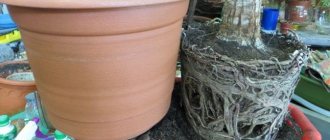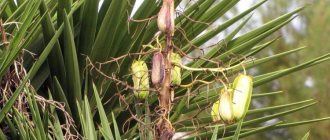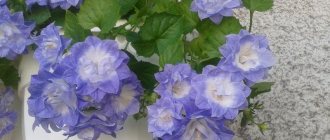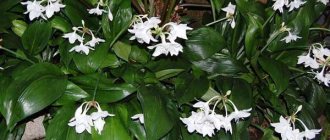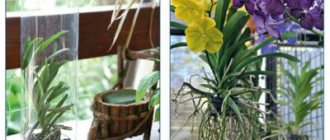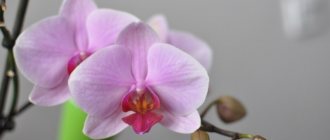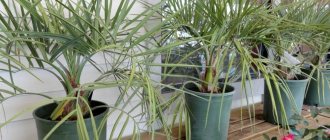Types and varieties
There are many varieties of the plant that differ from each other. Yucca
leaves Thanks to them, the plant is very hardy and can grow in different conditions. Important! The botanical name of elephant yucca is Yucca elephantis.
Popular plant types:
Yucca elephantipes
This is the most common type. The flower is distinguished by its unusual trunk shape. Outwardly, it looks like an elephant's leg. In nature, the bush reaches 9 m in height . The leaves are narrow, but very large.
They grow up to 120 cm long. At home, the plant is compact and does not bloom.
Yucca filamentosa
The flower's homeland is Texas. The plant is unpretentious and tolerates low temperatures and drought.
Yucca aloelia Marginata
The plant is found in Mexico and the USA. Yucca is presented in the form of a bush. The stem is underdeveloped. Mature plants reach 8 m in height . Externally, the flower is very similar to scarlet, which is why it got its name.
Each leaf has a splint that makes the plant prickly. The plates are long and bright. They do not fall off like other species, but wither and bend down, covering the stem.
In nature, this species blooms. The peduncle reaches 0.5 m in height. Inflorescences are white and purple. Each open bud reaches 3 cm in length.
Yucca glauca
This species is often called bear grass or Spanish bayonet. This is an evergreen flower that has hard foliage plates of a bluish or green-blue hue. The bush grows up to 2 m tall.
The leaves are long, up to 60 cm long. Fibers are visible at the edges, entangling the plates with each other. The peduncle reaches 1 m in height. The flowers are small. They may be white or greenish.
Important! Yucca filamentosa is the species most suitable for cultivation in the Middle East and Europe.
Botanical description of the plant
Elephant yucca (lat. Yucca elephantipes) is also known to science under the name giant yucca (lat. Yucca gigantea), and in common people it was called a false palm. The natural habitat of this species is the countries of Central America and eastern Mexico, where its representatives grow up to 6–9 m in height and 4.5 m in crown width. At home, the plant's growth usually does not exceed 3 m.
This yucca owes its name to the fact that in a mature representative the trunk resembles an elephant’s foot - it gradually becomes woody, becomes thicker at the bottom, and the lower leaves die off. The trunk of the plant can also branch. The hard leaves of the plant are lanceolate and have sharp, slightly jagged edges. In nature, their length can reach 1.2 m with a width of 8 cm.It blooms in summer and autumn with large flowers, shaped like bells, white, collected in brushes. Flowering almost always occurs only in open ground in warm climates. The flowers are protected by perianths of 6 leaves. During flowering, an ovary is formed from many ovules. The pistil is short, three-lobed. Yucca bears fruit with juicy, brown, oval-shaped fruits that reach a length of 2.5 cm.
Did you know? Fibers from another representative of the genus, yucca filamentosa, are added to fabric for sewing jeans in the USA, which increases its strength.
Home care
Yucca elephant does not require special care. In order for a flower to be attractive and bright, it is enough to adhere to the rules of watering, air temperature, and lighting.
Lighting
The plant develops best in a room with diffused light. A good place are windows that face east or west.
Important! In winter, it is recommended to highlight the flower. To do this, install phyto-lamps near the flowerpot. They should be placed half a meter from the leaf plates. It is necessary to keep the lamps on for at least 6 hours a day.
In the summer, the plant should be exposed to fresh air. This could be a balcony or terrace.
Temperature
During the hot season, yucca should be kept at a temperature of about +220C . In winter, the thermometer readings drop to +150C. The flowerpot must not be placed near heating appliances or under the air conditioner.
Advice! When growing yucca at home, you should remember that the plant does not react well to sudden changes in temperature. This may cause the flower to begin to lose its attractiveness.
Air humidity
If you want the bush to have an attractive appearance, then you need to provide it with appropriate air humidity.
To do this, in the hot months, place a tray with water and pebbles near the flowerpot. also recommended to systematically wipe the leaves with a damp cloth. It is not necessary to spray the flower.
How to water
A lot depends on proper irrigation. In summer, the procedure is carried out every two to three days. In winter, watering is reduced, otherwise the root system will begin to rot . Water should only be used well-settled and at room temperature.
This video shows Yucca and tells you how to care for the tree-like plant.
Flowering period
All types of yucca are capable of blooming, but at home it is almost impossible to see colorful inflorescences. In order for the buds to form, the plant must be provided with a long wintering period.
Feeding fertilizers
This is a very important procedure. They begin to fertilize in early spring and until the end of summer. are applied once every 20 days. To do this, use mullein infusion or special mineral complexes.
How to replant a false palm
When transplanting yucca, you need to pay special attention to the choice of soil. It is best to use nutrient soil. You can either buy it or prepare it yourself.
The container should be deep. It is necessary to lay a layer of drainage at the bottom of the flowerpot, the thickness of which should be within 5 cm.
Before planting, the roots of the plant will need to be completely freed from soil . To do this, place the yucca in a bucket of water for a day.
This video shows how to properly transplant Yucca.
Plant characteristics
Yucca ivory (photo) is distinguished by sword-shaped, penetrating leaves of a lance-shaped, pointed shape, protruding in different directions, with hard, long hairs along the edges. Their length is 25-100 cm, width - 1-8 cm. In the rosette they are collected in a green bunch. White or yellow stripes are sometimes present on the leaf blades.
During flowering (if the yucca does not bloom, read our article), many white, pink or yellowish bell buds appear on powerful vertical peduncles, which gives the plant an unusual exotic look.
Classification of yucca by type
Room. Grown as an ornamental plant and for medicinal purposes. It must be placed in rooms with high ceilings, as it can reach 4 m in height. Feels good in large pots with drainage, in the summer - outdoors, in the winter - indoors with bright lighting and cool air. After many years, she can please you with white flowers in the form of bells. Its leaves are green, slightly bluish, sword-shaped, linear, collected in a bunch at the top of a powerful trunk.
Aloe leaf. Due to the absence of side shoots, it is most in demand among plant growers who love exotic plants. Its tree-like trunk has notches left from fallen, dried leaves. From hard greenish-bluish leaves, 2-3 sparse rosettes are formed at the top of the trunk. Vases with the plant should not be placed where people often move, since the sharp, long lance-shaped leaves with a leathery surface, up to 50 cm long, can cause injury, a cut or puncture by the tip of the leaf. With the correct watering regime, the tree will be beautiful, spherical and healthy. In summer, a bush or tree can delight you with paniculate creamy-white inflorescences.
Threaded . It has almost no stems, is resistant to pests and short-term frosts within 20°C, tolerates hot drought well, and quickly takes root indoors. Height - 200 cm, leaves are bluish-green, up to 70 cm in length, they have pointed tops, numerous white and thin thread-edges grow on the edges of the leaves. The end of the trunk is decorated with a panicle with yellowish-white, piercing flowers. With rapid growth, shoots-stolons may appear. Occasionally, round fruits may grow. The roots penetrate deeply and fill the entire container, and shoots appear from them.
Whippla. The plant is bush-like with a shortened stem, hard and fibrous grayish-green, leathery, elongated-lanceolate leaves, up to 100 cm long. They have prickly spines on the jagged edges. The top of the stem is decorated in summer with a paniculate inflorescence with a delicate aroma.
Elephant. With slow growth, a small tree or upright bush is formed, resembling an elephant's leg. At the ends of the branches of a highly branched tree-like stem, rosettes form from tough and fibrous light green leaves. The leaves have a leathery blade and are 50-100 cm long. The jagged edges end with a sharp short spine, so it is not easy to care for the plant indoors.
Less commonly found among gardeners are short-leaved, beak-shaped, radiata, glaucous, turned-leaved, glorious, southern and yucca schotta or trekula.
Similarities with dracaena
When purchasing yucca, you can make a mistake and buy dracaena because of their external similarity. These false palm trees require different care and different maintenance conditions.
Plants can be distinguished by the following characteristics:
- root system: dracaena does not form rhizomes, has a smooth and yellow root, orange or dark yellow on a cut, yucca has roots of a different color and has rhizomes;
- the presence of shoots: dracaena does not produce shoots, but yucca does;
- leaves: dracaena has soft and smooth leaves, yucca has hard and rough leaves;
- flowers: yucca has large and beautiful flowers, dracaena has small and white-green flowers, collected in panicles and emitting an unpleasant odor.
Dracaena needs moist soil and air, yucca needs dry soil and does not require copious spraying. If water accumulates in the leaves, it will begin to rot. Dracaena is propagated using cuttings and root shoots, yucca is propagated by seeds, dividing the trunk along with the root, and cutting off the top of the plant.
How to prune yucca
Since Yucca elephantis grows very tall, it requires pruning at home. The procedure should be carried out as the plant grows. Trim the top of the bush.
This should only be done with sharp garden shears or pruning shears. Thanks to this, new shoots will appear on the stem, which will give the bush an attractive appearance.
Trim time
It is best to deal with the yucca crown in the last month of winter after the end of the dormant period. From November to February, the plant was in a cool room (about 10 degrees Celsius), gained strength and was ready to increase its vegetative mass. If the yucca has not had a full rest in winter, the adaptation period and the release of shoots may be delayed.
On a note! Flower growers have noticed that the false palm tree should not be disturbed in April. The plant often dies due to problems with the healing of cuts.
So, the recommended period for the planned formation of yucca is February-March .
Reproduction of elephant yucca
Growing a new young plant at home is not that difficult. There are several ways to do this. All of them are effective, the main thing is to adhere to some rules.
Seed method
To sow seeds, use only light and nutritious soil. It can be prepared from sand, deciduous and turf soil . Before planting grains, the soil is well irrigated.
Yucca should be sown at a shallow depth. To make the seeds germinate faster, it is recommended to cover the top of the container with transparent glass or polyethylene. A month after germination, the seedlings can be transplanted into separate pots.
Reproduction of yucca by shoots
This method is often used by gardeners. To do this, the lateral processes are separated and placed in wet sand. After the roots appear, the seedlings can be moved to separate containers .
This video shows one of the ways to propagate Yucca by shoots.
Cuttings
Planting material should be about 10 cm long. All separated parts are placed in a substrate of sand and soil. Each cutting is covered with a bottle or jar.
After the first leaves appear at the cutting sites, the cuttings are removed and the shoots are separated. Young specimens are planted in breathable soil.
Competent care
If Yucca Elefantis has already entered your apartment, care at home comes down to creating comfortable lighting, temperature conditions and humidity for it. It is important to choose the right soil for the false palm tree, water it correctly according to the season, fertilize it, feed it, and replant it. Let's consider all positions in more detail.
Replanting after purchase
In specialized branded stores, yucca is kept in pots intended only for transportation and not for keeping for a long time. In stores, the root system of plants is fed with special hormones. At home, such feeding stops, the land is depleted. To prevent Yucca Elefantis from dying, home care involves transplanting the young plant into soil with an acidity of 5.7-7.4 pH within 2 days. Alkaline soil is not suitable because the root system from it will not be able to absorb and assimilate the necessary microelements.
Choosing a pot
First of all, you need to prepare a pot, which should not be too large, but only 2-3 cm larger than the diameter of the store-bought pot and, accordingly, the root system (the old store-bought one should fit freely into the new one). If the pot is very large, the root system will take a long time to compact, and this will slow down the growth of the false palm. The root will absorb all the nutrients for its growth, and the crown will experience a nutritional deficiency and suffer.
The depth of the new container should exceed the internal diameter by 2-2.5 times in order to lay drainage at the bottom in 3-5 layers of expanded clay or broken brick. The container for yucca should be natural: clay or ceramic with a drainage hole. Although many people also use plastic pots, making a hole in their bottom to drain excess moisture. It is important that the container is not deformed or overly fragile.
Soil mixture for replanting
The soil mixture can be purchased at the store or prepared yourself. For this you will need:
- according to recipe No. 1: compost, sand (perlite), turf soil, humus - in equal parts by weight;
- according to recipe No. 2: pebbles or dolomite crushed stone of a fraction of 1.2 cm, coarse peat, coarse perlite, pumice - 1 part each, pine bark with a layer of 2 cm, charcoal - 1 cm, bone meal - 0.1 part.
Water will pass through this soil composition well and will not become salty. On top of the drainage, carefully fill the container with soil, leaving no pockets of air. The palm tree is carefully pulled out of the old pot along with a lump of earth, then placed in a container with a substrate, compacted a little with a spatula. To give stability and prevent stem rotting, the yucca is buried 3 cm into the soil, but no more. Then, after abundant watering, the pot with the plant is placed in a dark place without drafts and with an air temperature of +24/25°C, not lower. After 6-8 days, the plant will adapt indoors and can be installed in a permanent place.
Lighting
Yucca elephant: care at home requires good lighting, especially important for young plants. Pots should be placed on the windows from the young side, southeast or southwest. In bright direct sun, you will have to move them away from the window or shade them, since the sensitivity of young plants to the effects of rays is higher than that of adults.
With a lack of light, the shoots will begin to unattractively stretch and bend, the leaves will begin to thin, turn pale, turn yellow and fall off. In winter, artificial lighting lamps are installed for yucca to extend daylight hours to 16 hours. It will feel good in winter at an air temperature of +8-10°C, for example, on a heated loggia. If it is not possible to create a lower temperature, then place the pot on the windowsill closer to the glass and periodically open the window sashes or window for short-term winter ventilation. In this case, it is necessary to exclude drafts and sudden temperature changes.
Soil moisture and irrigation
Dry soil is moistened once every 7-8 days in summer and every 10 days in winter. By the arched and bent down leaves, you can understand that the false palm is feeling well, and it is not yet time to water. When the soil dries to a depth of 5-7 cm and the leaves curl into a tube around the central vein, you need to water it generously and make sure that excess water does not stagnate, but flows into the pan.
If the air is dry in winter or if the plant is outdoors in summer, it is sprayed every other day. The water temperature should be room temperature. Indoors, the leaves of the flower will absorb this artificial dew better if they are periodically wiped from dust. Outside, the dust can be washed away by rain. If grayish-brown spots appear on the leaves, these are symptoms of high humidity and disease. Then you should remove the diseased leaves and spray the flower with a fungicide.
It is important to know . If there is a lack of moisture, the plant will not bloom; if there is too much, the root system will rot and the development of the plant will stop.
In winter, the palm tree is watered around the circumference of the pot, preventing water from entering the outlet between the trunks to prevent rotting. It is not necessary to spray additionally in dry air in winter, although it will not cause harm.
Plant nutrition
During intensive growth in spring and summer through September, feed the palm tree once every 15-20 days, but only after the plant has adapted to the new conditions. In winter and when treating diseases, fertilizing is not applied. During the growing season, yucca will feel good when fertilized with complex mineral fertilizers or a mixture of mullein, leaf humus and horse manure.
Transplantation in open ground and pots
If Yucca Elefantis is already growing in a flowerbed, how to replant it? Every 2-3 years, the false palm tree is replanted in early spring, although it can be done throughout the year, but not in the fall. The root system cannot be damaged, so it is dug up with a lump of earth or removed from the pot. Dry leaves are removed. Recommendations about replanting in pots were given above. When planting a palm tree in a new flowerbed, prepare a hole for a young plant, the width and length of which are 80 cm, the depth is 60 cm, and for an adult the depth should be 10 cm more.
The pit is filled with black soil with fine gravel, sand, and compost in equal parts by weight. Part of the moistened mixture is poured into the hole, the yucca is placed, then the rest of the mixture is poured on top and warm, settled water is poured in. For a week after planting, it is sprayed daily.
If a palm tree has more than one trunk, it needs to be replanted:
- divide the trunk together with the root into parts and plant each separately in the ground or in its own (separate) pot;
- Sprinkle the cut areas with activated carbon powder or cover them with garden pitch;
- Before transplanting, cut off a third of the leaves and keep the root in warm water for 2 hours;
- When replanting, add vitamin fertilizer to the soil.
It is important to know. It is better not to replant the yucca in the fall, as it is preparing for winter rest. When transplanted in autumn, the flower will devote all its strength to adaptation and rooting, so it may get sick in winter. It can be planted in a pot from February, and in the garden in the spring, when good weather sets in.
Pruning and crown formation
To control the growth of Yucca Elefantis, prune and shape the crown. After pruning, the trunk will stop growing in height and will not increase in diameter. On a trunk 5-6 cm thick, 1-4 dormant buds are left. If the trunk thickness is less than 5 cm, no more than 2 buds are left, if more than 5 cm, then 4 dormant buds. At the end of February - beginning of March, before the period of active growth, the trunk is cut with a sharp knife, first it is wiped with alcohol, and not with alcohol-containing liquids.
Cutting off a woody trunk is not so easy. The cutting location is chosen at a certain height from the ground surface. You should hold the leaves gathered in a bunch with one hand, and remove the stem with the other. The crown must be cut off to the end, and not broken off, otherwise the growing points will be damaged. The cut area should be disinfected and sprinkled with activated carbon powder. In a month, with good watering (1-2 times a week) and lighting, new young leaves will appear. After 20-25 days, shoots will emerge from the dormant buds, and the yucca will begin to increase their thickness.
The cut off top can be useful for growing a beautiful new yucca in a separate pot.
Diseases and pests
Like most indoor decorative flowers, yucca often suffers from insects. It can be affected by scale insects, thrips, mealybugs, aphids, leaf beetles, and caterpillars . Fight such insects with soapy water or insecticides.
Leaves are drying
If the leaf blades of the plant begin to change color and dry out, then a sign of this may be a lack of sunlight. And also changes occur when exposed to direct sunlight . In this case, the flowerpot should be moved to a room whose windows face the west or east.
The leaves are turning yellow
A sign may be either excess moisture or the use of cold water. Also, the leaves turn yellow with sudden changes in temperature.
Yucca elephant is a unique plant that, with proper care, will decorate any room. To achieve the desired result, you just need to follow simple growing rules.
This video shows Yucca pruning and one of the methods for replanting it, and also talks about the propagation of the tree.
Reasons for pruning
Yucca is a false palm. In most cases, if the crown is made up of a single rosette of sword-shaped leaves formed by the top of the trunk, the plant does not look very presentable. Indeed, a thin, elongated (up to 2.5 m) stem with a patch of leaves near the ceiling is a depressing sight.
The florist begins to look for ways to increase the diameter of the crown and its density. The decorative and aesthetic appearance of a false palm tree can only be achieved by pruning . This effective measure forces the yucca to branch, turning the palm tree into an exotic bush.
Sometimes in practice a different situation arises - the plant unexpectedly produces a lateral sprout. Moreover, for some reason the bud wakes up at the base of the trunk. The large difference in height between the crowns also does not look very attractive. There is only one way out - partially cut off the stem.
Propagation by seeds
Own planting material can be obtained from indoor yuccas only in a greenhouse. Street plants produce seeds on the Black Sea coast of the Caucasus, South Coast, Georgia or Azerbaijan. Hobbyists are forced to make purchases at garden centers or online.
Yucca species and some varieties can be grown from seeds. Variegated cultivars do not inherit the characteristics of the mother bush with this method of breeding.
The most common mistake when propagating by seeds is that the hosts carry out stratification. That is, before germination, planting material is exposed to low temperatures. But yucca seeds do not go into a dormant state; such an operation can lead to loss of germination.
But scarification, a violation of the integrity of the shell, helps to quickly saturate dry seeds with moisture, and the sprouts hatch earlier. It is recommended to rub the durable peel with sandpaper or scratch it with a needle.
Yucca has poor germination; the culture takes several months to a year to germinate.
Propagation by seeds, step by step:
- The shell is damaged with a needle or lightly rubbed on one side with sandpaper.
- Place a paper towel, gauze folded in several layers or cotton pads in a wide bowl.
- Yucca seeds are placed on top and filled with water so that the liquid does not cover them completely. Otherwise, the planting material will simply “suffocate” and die.
- Cover with glass or cellophane.
- Keep warm (18-24° C), in the light, ventilate daily for 20-30 minutes, add warm water as needed.
- As soon as the shell cracks, the seeds must be planted in peat with sand to a depth of 1-1.5 cm. You cannot wait for the root to appear (it is the root that hatches first, and not the shoot), otherwise the shoot may break or be injured during transplantation, and for yucca At this point, reproduction can be considered complete.
- Wet the substrate generously and cover it with film or glass.
- Care is the same as for unhatched seeds: heat, light, ventilation, high humidity.
- When the sprouts produce 2-3 true leaves, you need to plant the yucca in cups with bottom holes, drainage and a light soil mixture containing at least 30% sand. It is better not to disturb the root - take a teaspoon and simply transfer the seedling to an individual container along with a lump of substrate.
- Young plants are kept under film until a new leaf appears. Then they are gradually accustomed to fresh air.
- As the roots become entwined, the yucca is transplanted by transferring it into a slightly larger pot.
Outdoor yucca will have to be grown indoors (apartment or greenhouse) for at least 2 years.
Types of homemade yucca with photos and names
Yucca elephant
More often than other species found in home floriculture. The species was named after the shape of its trunk, which resembles an elephant’s leg. Elephant yucca grows slower than other species, but it also makes fewer complaints about living conditions than others. The lower part of the trunk is usually without leaves, the upper part branches into several shoots, densely overgrown with rosettes of long, dark green leaves, pointed at the apex. Young sword-shaped leaves stretch upward, droop to the bottom with age and dry out on the trunk.
Yucca aloefolia
On a dense, pronounced trunk, a dense rosette of sword-shaped leaves is formed in a spiral, wide at the base (up to 15 cm) and strongly pointed at the end. The dark green color of the leaves is covered with a bluish coating. The edge of the leaf blade is serrated and lighter. The plant practically does not bush, but can produce an attractive peduncle with large, creamy-white, bell-shaped flowers.
Yucca Vippla
This is a spherical bush, consisting of a voluminous rosette (up to 1 m in diameter) of long, fibrous leaves and a short, dense stem. The leaf blade is lanceolate-shaped, jagged along the edges, and has a sharp spine. The color is dull, gray-green. The rosette can produce one tall peduncle, but after flowering its above-ground part dies off, and in its place young shoots grow.
Yucca shortifolia
This is a type of large, garden yucca that grows in the southern states of America. It grows slowly in the form of a tree with a thick trunk; in nature it can reach a height of 10-15m. Intensive tillering begins at the top of the trunk. Short (up to 30cm) leaves in the shape of an elongated triangle are attached at the base to the side shoots and form a rosette. The edges of the leaf plate are decorated with small teeth and spines. It is problematic to maintain such a plant in a residential environment.
Yucca radiata
It is distinguished by the shape of its leaf blades, which are up to 60 cm long and densely attached to the trunk like rays. They are quite narrow, no more than 1 cm, with a sharp apex. The whitish, dense edges are covered with multiple fine villi.
Varieties
There are about 40 species of yucca that grow in South America and the southern part of the North American continent. Of these, only a few species can be grown indoors. Yucca ivory is one of them.
In the wild, this species can have a height of 8-10 m, but in apartment conditions it is rarely higher than 2 m. It forms side shoots quite easily, so it is easy to create a highly branched tree with many leaf rosettes from a yucca seedling.
Until recently, breeding of the elephant yucca species was not carried out. Yucca ivory, with its natural green leaves, was the only variety that was grown in apartments. Today there is a variegated variety called “Variegata”, the leaves of which are bordered with white or yellowish stripes.
Kinds
Yucca indoors.
Indoor yucca is grown as an ornamental plant, and it can also be used for medicinal purposes. The plant is similar to a palm tree, its height can reach 4 m, so it is suitable for placement in large halls. Planting this type of yucca requires a deep pot with good drainage. In summer, yucca is taken out into the open air, in winter it is kept indoors with a cool air temperature and sufficiently bright lighting. Indoor yucca will bloom with white flowers after many years. It has green, slightly bluish, sword-shaped, linear leaves, collected in a bunch at the top of the trunk.
An incredibly beautiful decorative yucca decorates a flowerbed with its sharp evergreen leaves in the shape of a sword, and during flowering it attracts with a tall peduncle with large white bells. It can be grown in pots without much difficulty, where it looks very impressive. Young specimens of three years of age are placed in three-liter pots; for an older representative of the agave genus, a ten-liter container is suitable.
Yucca aloefolia.
This is the most popular yucca among amateur plant growers. Its main difference from other species is that it does not have side shoots. On its tree-like trunk, planted with notches left over from fallen leaves, grow rather hard, green leaves with a bluish tint, collected in the form of two or three sparse rosettes. They are very sharp, you can even cut yourself on them, so it is better not to keep such plants in places where people move. When choosing this species, you must follow the correct watering regime, and then you will be able to grow a healthy and beautiful tree.
Yucca filamentosa.
The inhabitant of eastern North America takes root well at home because it is resistant to pests and tolerates heat and drought well. This is a stemless plant with bluish-green leaves with a pointed apex, with edges covered with numerous white, thin, curling threads. A flower panicle, composed of yellowish-white, drooping flowers, grows approximately 200 cm in height. The fruit has a round shape. The plant grows quickly and likes to produce shoots (stolons). Under the conditions of the botanical garden, breeders managed to obtain several varieties of this species.
Yucca elephant.
This is the most interesting species, its height reaches 10 m. An amazing plant, caring for which consists of following some simple rules, is widely used in industry and medicine. Rope is made from strong fibers, and the juice of the leaves of the plant is used as a basis for some hormonal preparations. The native places of growth of this indoor plant are Mexico and Guatemala. The imported stems are cut into fragments, planted in flower pots, they can be bought at any flower shop.
Location and lighting.
It is advisable to place the yucca pot in a sunny place, well lit during the day. The most favorable location for this house plant is window sills or floor stands near a window on the east or west side of the room. If the yucca is placed next to a south-facing window, then be sure to shade the glass in the summer and on sunny spring days so that diffused light falls on the plant. In the autumn-winter period, yucca may lack natural light. Therefore, it is advisable to place fluorescent lamps next to the plant (at a distance of 50-60 cm) as additional lighting. If possible, place the pot with the plant on the balcony or near the house in the summer, slightly shading it from direct sunlight.
Temperature regime.
The optimal temperature in autumn and winter is 10-14°C. Problems can begin with the onset of the heating season - at temperatures above 16°C (especially in low or insufficient light), the leaves stretch out, become thinner, and the turgor weakens. If possible, place the pot with the plant on a glassed-in balcony or install an air conditioner near the plant, and ventilate the room more often. Comfortable temperature for homemade yucca in summer is 18-25°C.
Air humidity.
The best option is a moderate level of humidity in the room (40-50%). But dry air will not harm the plant if you regularly spray the yucca with settled, boiled and warm water from a spray bottle. In summer, you can wash the leaves of the plant several times in the shower so that water does not get into the substrate. In hot weather, you can place a pot with a plant on a tray with wet river sand or expanded clay, and place a wide container of water nearby to increase the humidity level.
Watering.
In summer, yucca is watered abundantly after the top layer of soil (4-5 cm) has completely dried. It is important not to allow water to stagnate at the level of the earthen clod - immediately pour all excess water out of the pan. In the autumn-winter period, water the plant very rarely (once every 10-15 days). Yucca tolerates drought quite calmly, but overwatering can cause rotting of the root system, as well as damage to the plant by diseases and pests. Some novice gardeners use a special moisture indicator to determine the degree of drying of the soil layers.
Earth mixture and fertilizing.
You can prepare the soil mixture for your yucca yourself. If the plant is young (up to 4 years), then mix turf soil, leaf soil, coarse sand and humus in a ratio of 2:2:2:1. Mixture for planting an adult plant: turf soil, leaf soil, river sand in a ratio of 3:2:2.
For feeding, you can use diluted mineral fertilizers or prepare them yourself (for example, an infusion of horse or cow manure with leaf humus). You can additionally spray the leaf blades from the underside with diluted mineral fertilizers. In spring and summer, fertilizing is applied once every few weeks. It is not recommended to fertilize the soil in winter and autumn.
Transfer.
Homemade yucca is replanted as needed (given that the plant grows very slowly) in the spring approximately once every two years, except in emergency cases if the roots begin to rot severely. It is advisable to use the transshipment method when transplanting into a ceramic pot in order to keep the earthen ball intact. Carefully inspect the yucca root system and, if necessary, remove rotten roots.
Trimming.
With the help of pruning, you can significantly improve the appearance of the yucca, making it a “lush palm tree”, using the rudiments of new shoots to grow additional tops. It is desirable that the height of the plant be 60-70 cm and the diameter about 6 cm. The procedure is performed in March-April, watering abundantly a few days before. Use only sterile pruning tools and thoroughly disinfect the sharp knife with alcohol. We choose the place of the cut, retreating 7-8 cm from the lower leaves. We grab the leaves with our hands and sharply cut off the trunk in one movement. Then the cut area is sprinkled with crushed activated carbon. After a few weeks or earlier, apical buds (from 2 to 5 pieces) will appear in the upper part of the cut trunk. If the trunk thickness is less than 5 cm, then leave 2 buds and cut off the rest. And if the thickness is 6-8 cm, then we leave 4 buds, from which the tops with new leaves will grow.
